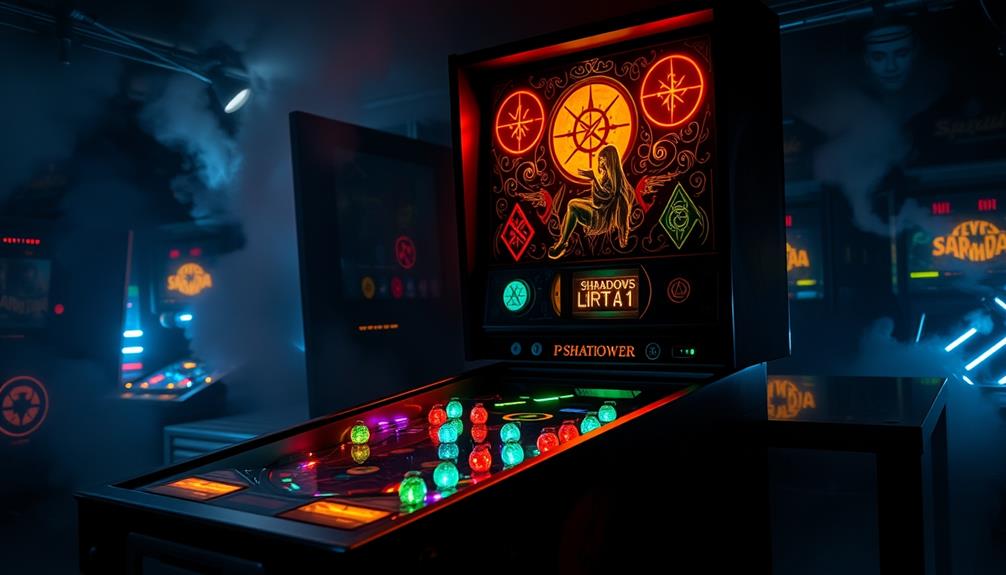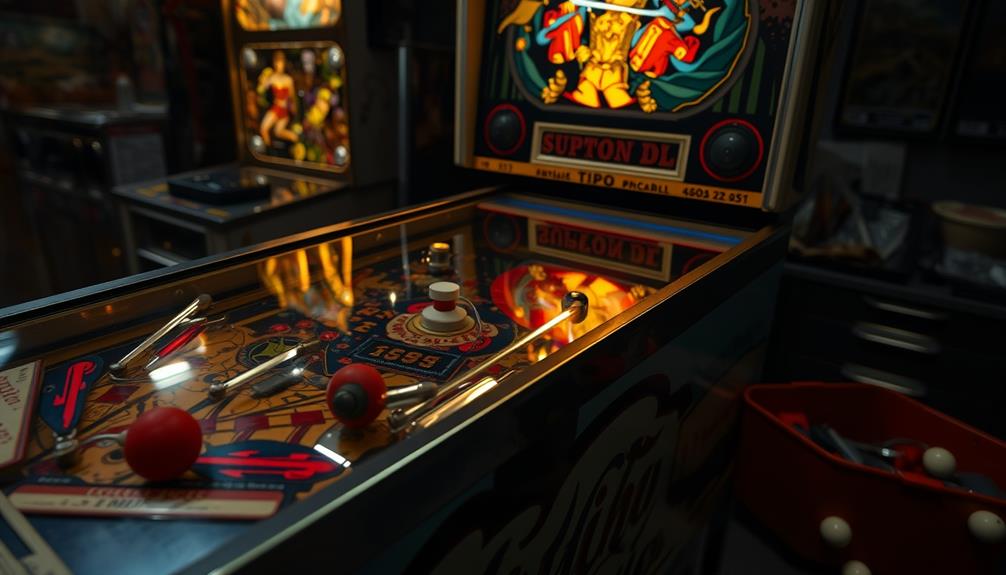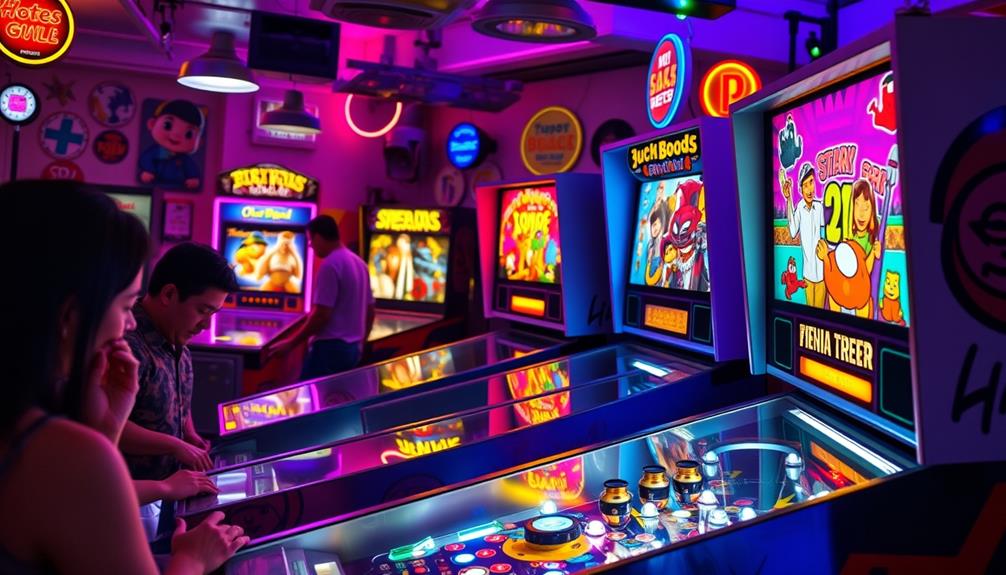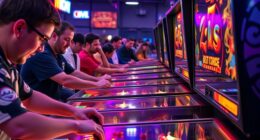Pinball machines were legalized in the mid-1970s, signifying a significant cultural change. Prior to that, cities like New York and Chicago prohibited them, considering pinball to be a form of gambling and a catalyst for youth delinquency. However, in 1974, the California Supreme Court declared pinball a game of skill, generating public interest. New York lifted its ban in 1976 after a demonstration by Roger Sharpe demonstrated the game’s skillful aspects. Other cities followed suit, leading to a resurgence in popularity. For more information on the events that paved the way for this revival, continue exploring further.
Key Takeaways
- Pinball machines were legalized in New York City in 1976, ending a 34-year ban initiated by Mayor Fiorello La Guardia in 1942.
- The California Supreme Court ruling in 1974 classified pinball as a game of skill, prompting cities to reconsider their bans.
- Chicago also lifted its pinball restrictions in 1976, reflecting a broader trend of legalization across major cities.
- Roger Sharpe's demonstration in 1976 showcased the skill involved in pinball, influencing public perception and the NYC council's decision to legalize.
- The wave of legalization in the 1970s led to a resurgence in pinball's popularity, transforming it into a legitimate entertainment form.
Origins of Pinball Machines
Pinball machines trace their roots back to 18th century France, where they evolved from the parlor game bagatelle. This game involved hitting balls into pockets for scoring, resembling the lawn games of that era.
The change from bagatelle to what you know as pinball began in 1931 with the introduction of the first pinball machine, a coin-operated device by Automatic Industries. This marked a significant evolution in gaming, shifting from a simple game of chance to a more interactive experience. Understanding the financial implications of investing in collectibles like pinball machines can be beneficial, as investment strategies can help maximize potential returns.
In 1871, Montague Redgrave introduced the ball shooter, revolutionizing gameplay by allowing you to launch the ball without a cue. This innovation paved the way for increased player engagement.
By the 1930s, advancements like electric scoring and sounds contributed to the growing popularity of pinball in amusement venues. The real game-changer came in 1947 when D. Gottlieb Company introduced flippers, transforming pinball into a skill-based game rather than just a game of chance.
These developments solidified pinball's status in entertainment culture, evolving from its humble beginnings into the enthralling machines you enjoy today. These innovations not only enhanced gameplay but also transformed pinball into a blend of art, technology, and skill. With their flashing lights, intricate designs, and immersive themes, modern pinball machines captivate players of all ages. As one enthusiast put it, the magic of an ‘em pinball machine explained‘ lies in its mechanical precision and nostalgic charm, bridging the gap between past and present.
Legal Bans on Pinball

In the 1940s and 1950s, you'd find pinball machines banned in major cities like New York and Chicago, with officials claiming they fueled gambling and crime.
These restrictions were influenced by societal fears, similar to the stigma surrounding certain mental health disorders, such as Borderline Personality Disorder (BPD), which often leads to misunderstandings about emotional instability.
Public concern over juvenile delinquency sparked a movement against these machines, leading to the destruction of thousands of them.
However, as the perception began to shift, a legal battle emerged that would change the fate of pinball forever.
Early Legal Bans
During the early 1940s, you might have been surprised to find pinball machines banned in several major U.S. cities, including New York City. Mayor Fiorello La Guardia spearheaded the campaign against them, branding pinball as a gambling threat that contributed to organized crime and juvenile delinquency. In 1942, this ban resulted in the confiscation of over 2,000 machines, which were publicly destroyed as part of a moral crackdown.
Other cities quickly followed New York's lead, enacting similar bans that furthered the stigma surrounding pinball. However, this perception began to shift in the 1970s. A landmark ruling by the California Supreme Court in 1974 classified pinball as a game of skill, not chance. This pivotal decision laid the groundwork for changes in the legal status of pinball machines.
| Year | Event |
|---|---|
| 1942 | NYC bans pinball machines |
| 1974 | CA Supreme Court rules on pinball skill |
| 1976 | NYC lifts ban on pinball machines |
| – | Shift in public perception begins |
As a result, pinball started to gain acceptance as a legitimate form of entertainment.
Public Opposition Movement
As pinball machines gained some acceptance in the 1970s, a robust public opposition movement had already shaped their early history. This movement emerged in the 1940s, fueled by fears linking pinball with gambling and juvenile delinquency. Concerned citizens rallied against these machines in public spaces, viewing them as corrupting influences on youth.
Mayor Fiorello LaGuardia led the charge in New York City, enacting a ban in 1942 and overseeing the destruction of over 2,000 machines. Other cities like Chicago, Boston, Milwaukee, and New Orleans quickly followed suit, reinforcing the stigma around pinball. The perception of pinball as a harmful activity paralleled concerns about other recreational pastimes, leading to public calls for restrictions on various forms of entertainment, including essential oils for dizziness relief.
Despite the introduction of flippers in 1947, which showcased skill in gameplay, the perception remained that these machines facilitated illegal gambling. The opposition movement persisted into the 1950s, maintaining pressure on lawmakers to uphold bans.
It wasn't until the legal landscape began to shift in the 1970s that attitudes started to change. In 1976, a pivotal demonstration by Roger Sharpe highlighted the skill involved in pinball, ultimately leading to New York City lifting its ban and paving the way for broader acceptance of this iconic game.
Cultural Perception of Pinball

Pinball's journey from a banned pastime to a beloved form of entertainment showcases a dramatic shift in cultural perception. In the 1940s, cities across the U.S. imposed bans on pinball, associating it with gambling and juvenile delinquency.
New York City Mayor Fiorello La Guardia spearheaded the anti-pinball movement, claiming it was a mob-controlled racket, leading to widespread confiscation efforts. This stigma permeated society, causing many to view pinball as little more than a dangerous vice.
Curiously, similar shifts in public perception can be seen in how the careers of celebrities like Benatars Daughters' Careers have evolved over time, transforming from familial legacies to influential figures in their own right.
However, the 1970s marked a turning point. The California Supreme Court ruled in 1974 that pinball was a game of skill, challenging its longstanding association with gambling. This legal recognition helped reshape public perception, and as players began demonstrating skill-based gameplay, attitudes began to change.
The lifting of New York City's ban in 1976 signaled a significant cultural shift, allowing pinball to reemerge in community spaces.
Key Events Leading to Legalization
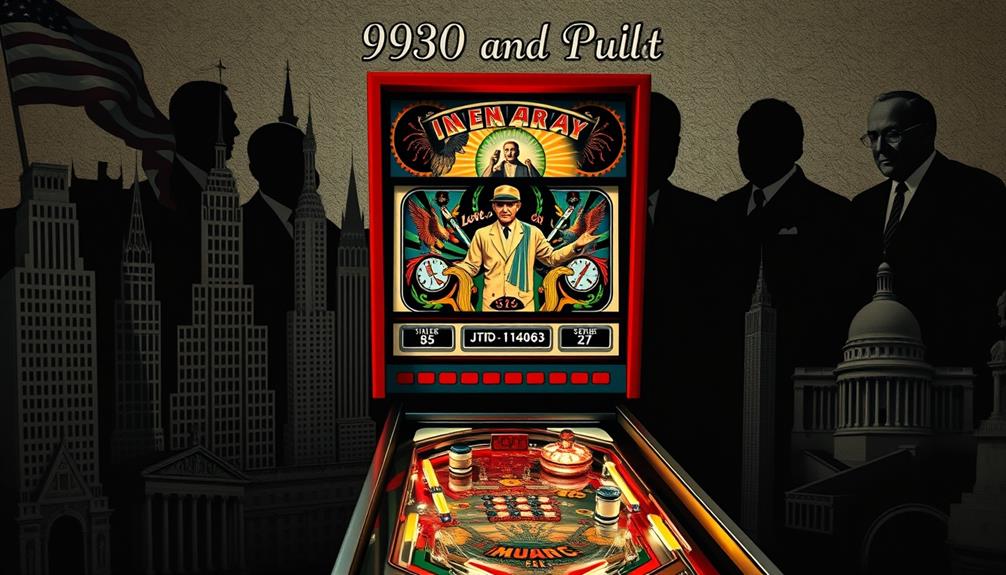
The shift in public perception set the stage for key events that would lead to the legalization of pinball machines. Initially banned in 1942 under Mayor Fiorello La Guardia due to moral concerns and gambling associations, pinball faced an uphill battle.
However, significant changes began to emerge, reflecting a growing recognition of the game's cultural value and its potential for economic benefits—content relevance and authority played an essential role in changing opinions.
- The California Supreme Court's 1974 ruling identified pinball as a game of skill.
- In 1976, New York City considered lifting its ban amid a pressing financial crisis.
- Top player Roger Sharpe demonstrated the skill involved in pinball, enthralling both the public and the council.
- The council ultimately projected a potential $1.5 million in licensing revenue, which encouraged other cities to relax their restrictions.
This pivotal moment in history transformed pinball from an underground vice into a legally accepted form of entertainment.
The successful repeal of the ban not only marked a significant cultural shift but also paved the way for legalization efforts across various states. As cities recognized the economic benefits of pinball, the game became a celebrated part of American culture, proving its staying power and the importance of skill in its gameplay.
The Role of Roger Sharpe

Roger Sharpe played an essential role in changing the fate of pinball machines in New York City during the 1976 council hearing. His demonstration was a pivotal moment that showcased pinball as a game of skill rather than a form of gambling.
By skillfully hitting a series of targets, Sharpe countered the long-held perception that pinball was purely based on chance, much like how trust issues with boyfriends can stem from miscommunication and misunderstandings. This live demonstration captivated the city council, making them reconsider their stance on the legalization of pinball.
The potential for $1.5 million in licensing revenue from legal pinball operations further swayed the council's decision. By recognizing the financial benefits, they began to see pinball in a new light.
Sharpe's efforts marked a major cultural shift, transforming pinball from a vice into a legitimate form of entertainment. As he stood before the council, it became clear that pinball was more than just a game; it was a reflection of changing attitudes in society.
Thanks to Roger Sharpe's passionate advocacy, New York City embraced the legalization of pinball machines, paving the way for a vibrant gaming culture that still thrives today.
Legalization in Major Cities

In the wake of shifting societal attitudes, major cities across the United States began reconsidering their stance on pinball machines during the mid-1970s. The tide turned when the California Supreme Court declared in 1974 that pinball was a game of skill, which spurred other cities to follow suit. This change in perception mirrored the growing acceptance of various forms of entertainment, as seen in the rise of family photoshoot fails that highlight humorous moments in family activities.
- New York City legalized pinball in 1976 after a 34-year ban initiated by Mayor Fiorello La Guardia's anti-gambling campaign.
- Chicago lifted its strict regulations the same year, inspired by rising public acceptance of the game.
- A pivotal moment occurred when top player Roger Sharpe demonstrated the skill involved in playing pinball, swaying the New York City council to overturn the ban.
- This movement led to a resurgence in pinball machines, transforming the perception from a moral threat into a legitimate form of entertainment.
As these cities embraced pinball, manufacturers capitalized on the newfound legalization, setting the stage for a vibrant pinball culture.
The combined efforts of players, advocates, and changing mindsets ultimately paved the way for pinball's acceptance in major urban centers across the country.
Impact on Pinball Popularity
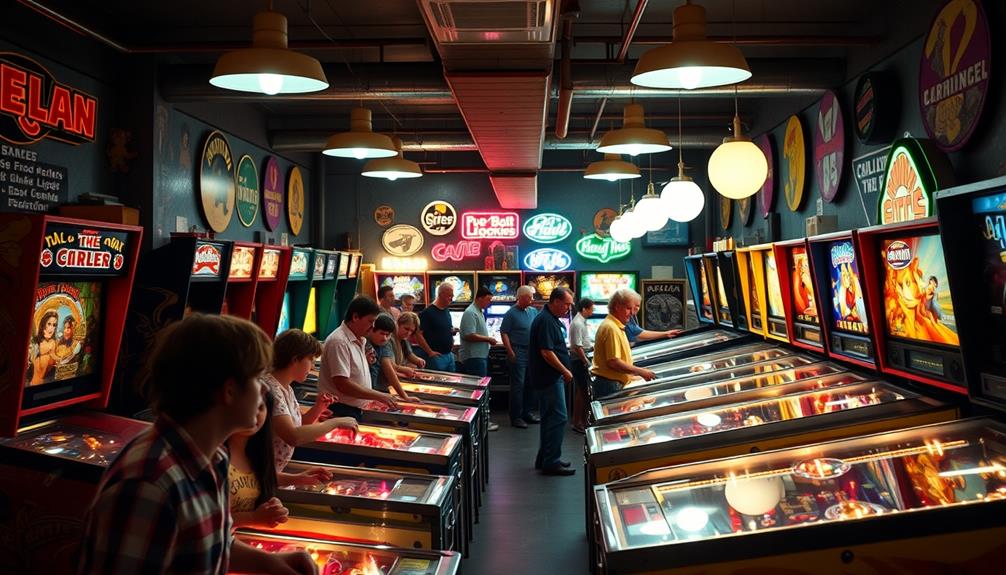
Legalizing pinball machines in major cities sparked an undeniable resurgence in the game's popularity. After years of prohibition, New York's 1976 decision opened the floodgates for public play in arcades and bars. This legalization fueled a nationwide revival in the late 1970s and 1980s, attracting both casual players and dedicated enthusiasts.
| Factor | Impact |
|---|---|
| Legalization | Allowed public play |
| Competitions | Built a thriving community |
| Skill Recognition | Increased game legitimacy |
| Sales Boom | Iconic machines flourished |
The California Supreme Court's ruling in 1974, classifying pinball as a game of skill, further legitimized it. This shift led to a surge in competitive pinball leagues and tournaments, enhancing the game's visibility. You'll find arcades buzzing with excitement, as players showcase their skills in thrilling competitions.
As the popularity soared, sales skyrocketed in the early 1990s, with machines like The Addams Family selling over 20,000 units, cementing pinball's status in popular culture. The revival not only redefined entertainment but also built a vibrant community that still thrives today.
Modern Pinball Landscape

You might be surprised to see how pinball has evolved in today's gaming world.
With industry trends leaning towards innovative designs and technology, competitive events are thriving like never before.
This resurgence in popularity can be attributed to a growing community that values the balance between technology and traditional gameplay, fostering curiosity and happiness among players.
Whether you're a player or a spectator, there's an exciting scene waiting for you to explore.
Current Industry Trends
Many enthusiasts today are thrilled to see the modern pinball landscape thriving like never before. The revival of pinball has sparked a surge in popularity, with a vibrant community of players and manufacturers shaping the industry's future.
This resurgence mirrors trends in other nostalgic entertainment forms, as seen in the cultural impact of Star Wars, which also fosters community engagement.
Here are some key trends to watch:
- Innovative Designs: Manufacturers like Jersey Jack Pinball and Spooky Pinball are pushing boundaries with unique gameplay experiences and advanced technology.
- Dominance of Stern: Stern Pinball continues to lead the charge, releasing new machines annually that blend classic themes with modern features.
- Social Hubs: Arcades are making a comeback as social gathering spots, where both new players and seasoned enthusiasts can connect.
- Competitive Spirit: With over 1,800 tournaments held annually by the International Flipper Pinball Association, the competitive scene is more exciting than ever.
These trends reflect a renewed interest in pinball, driven by nostalgia for classic gaming and a desire for innovative experiences.
As technology advances and community engagement grows, the future of pinball looks brighter than ever, inviting both old fans and new players to join in the fun.
Competitive Pinball Events
As the pinball community flourishes, competitive events are drawing in players and spectators alike, showcasing the thrill and skill involved in the game. The International Flipper Pinball Association (IFPA) has become a cornerstone of this movement, reporting over 1,800 competitive pinball tournaments held annually.
Major competitions like the IFPA World Championship and the Pinball Expo attract top players from around the globe, highlighting the growing popularity of pinball. This rise in competition parallels trends seen in other recreational activities, such as the increasing interest in diversification of retirement portfolios that encourage individuals to explore varied investments.
In 2021, participation surged, with the IFPA recognizing more than 33,000 players in their ranking system. This competitive scene features diverse formats, including knockout tournaments, league play, and head-to-head matchups, ensuring that players of all skill levels can join in.
Sponsorships and cash prizes at these events reflect pinball's increasing legitimacy as a competitive sport. As you immerse yourself in the world of competitive pinball, you'll find a vibrant community that not only celebrates the game but also fosters camaraderie among players.
Whether you're a seasoned pro or a newcomer, there's a place for you in this exciting landscape. Get ready to flip your way to victory!
Frequently Asked Questions
Why Were Pinball Machines Illegal in New York?
Pinball machines were illegal in New York due to a 1942 ban, labeled as a moral menace linked to gambling and crime. Critics claimed they exploited vulnerable citizens, fueling public support for the prohibition. In 1976, the ban was finally lifted in New York, and pinball machines were once again legal. However, pinball machine regulations in California were still in effect, with strict laws governing their use and operation. Over time, the perception of pinball machines as a moral menace began to fade, and they are now seen as a popular form of entertainment enjoyed by people of all ages.
Why Were Pinball Machines Illegal in California?
In California, pinball machines were seen as the devil's playground, linking them to gambling and juvenile delinquency. This perception sparked bans, fueled by public outcry and fears of organized crime's influence over entertainment.
Where Is Pinball Still Illegal?
You'll find pinball machines still illegal in certain jurisdictions, like Los Angeles and some smaller municipalities. Regulations vary widely, so check local laws to see where you can enjoy a game legally.
Was Pinball Illegal in Texas?
In a land where silver balls danced like stars, you'd find a game forbidden by law. Yes, pinball was illegal in Texas, a reflection of fears tied to gambling and the shadows of organized crime.
Conclusion
In the grand tapestry of gaming history, pinball machines are like resilient flowers breaking through concrete. Once banned and shunned, they blossomed back to life in the 1970s thanks to passionate advocates like Roger Sharpe. As cities embraced their charm, pinball transformed from a symbol of rebellion to a beloved pastime. Today, you can find vibrant pinball parlors, where every game tells a story, reminding us that joy can always find a way to shine through adversity.

